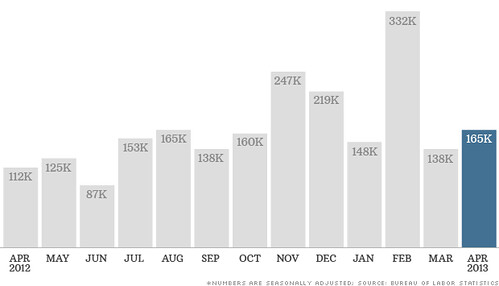
Source: Bureau of Labor Statistics
The U.S. economy added 165,000 jobs in April, which caused the unemployment rate to fall to a 4-year low at 7.5 percent.
More significant, perhaps, are the revisions to March’s gains (up 50,000) to 138,000 and February’s gains (up 64,000) to 332,000. Together, those upwardly revised numbers takes the sting away from March’s dismal numbers and helps to reduce some of the unevenness in job growth.
Meantime, joblessness continues to slowly tick lower. The unemployment rate dropped to 7.5% last month, compared to 7.6% in March. It has fallen from by 40 basis points since January.
Stocks rose following the better-than-expected jobs data. Dow Jones industrial futures gained 103.42 points to 14,767.58. Nasdaq composite futures increased 20.6 points to 2,903.94. S&P 500 futures was up 11.4 points to 1,592.62.
Still the economy is far from completely healed. The labor-force participation rate remains dismally low–remaining at 63.3% in April–at levels unseen since the 1970s, a period when an entire portion of the U.S. population (women) was less likely to work. And despite the upside surprise for the April data, the 165,000 jobs are woefully beneath the point at which the economy needs to reach to hasten the recovery. Economists say the nation must add nearly double that number, closer to 250,000 to 300,000.
The government is now the biggest drag on the job market. Overall, federal, state and local governments cut 11,000 jobs in April.

















